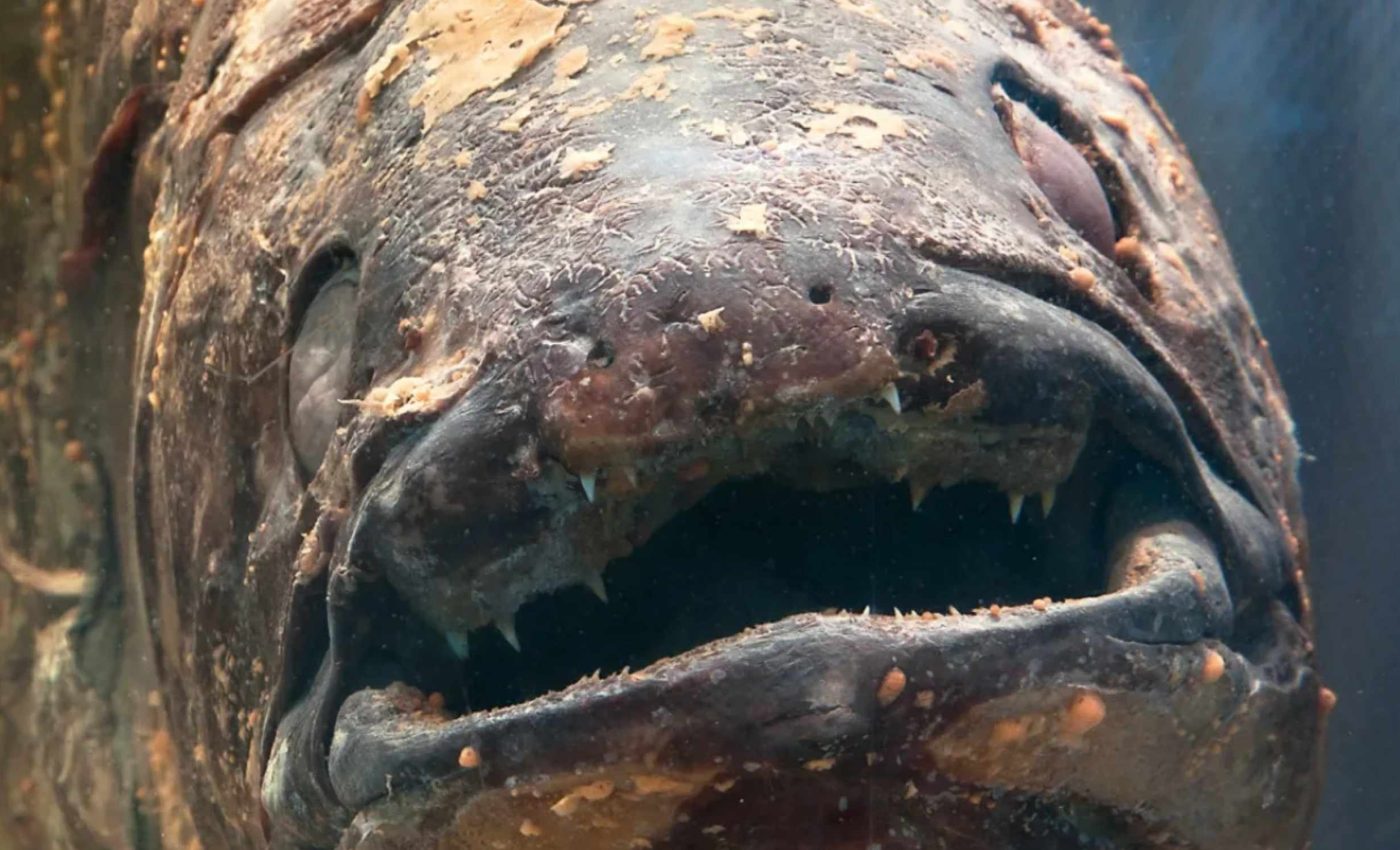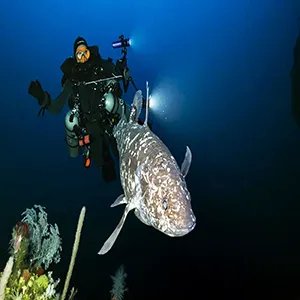
Scientists capture photos of a prehistoric fish thought to be extinct for 70 million years
At dawn in the deep waters off North Maluku, Indonesia, a team of technical divers raised their camera lights and found themselves face to face with a creature once known only from stone.
The brown spotted coelacanth, an ancient group of lobe-finned fish (Sarcopterygii) in the class Actinistia, famous for vanishing before the last dinosaur fell, a survivor of a lineage stretching back more than 400 million years, hovered calmly 475 feet below the surface.
The encounter, recorded in October 2024, was led by underwater explorer Alexis Chappuis of UNSEEN Expedition, whose lenses delivered the first photographs of Latimeria menadoensis in its natural Indonesian home.
Latimeria menadoensis
Modern science met an ancient rumor in 1938 when museum curator Marjorie Courtenay Latimer pulled the first living specimen of Latimeria chalumnae from a South African net, shocking paleontologists who thought the group had died out 70 million years earlier.
The discovery turned a textbook extinction into a living case study and launched a global hunt for other populations.
A second species, the Indonesian coelacanth Latimeria menadoensis, surfaced in a Sulawesi fish market in 1997, yet no diver had ever photographed it alive until now.
Remote submersibles had glimpsed shapes in dark caves, but human eyes at depth remained unconfirmed.
Both species mature slowly, reach about six feet in length, and can live nearly a century according to scale ring studies of their African cousin.
Long lives come with late puberty, around 40 years, and pregnancies that last roughly five years, leaving populations fragile.
The Maluku moment
Chappuis and teammate Julien Leblond descended with closed circuit rebreathers and a helium rich trimix gas blend to keep their brains clear at pressures four times those at the surface.
They landed on a steep volcanic slope at 410 feet, where temperature dropped to 68 degrees Fahrenheit and visibility stretched beyond 100 feet.
A white spotted silhouette emerged, dorsal fin erect, drifting over sponge covered rock. The divers kept a respectful distance, gathering five minutes of video before beginning a decompression ascent that would last more than three hours.
Two days later they returned, found the same individual Latimeria menadoensis fish swimming 30 feet shallower, and logged eight more minutes of observation.
Photo analysis confirmed the match by its unique lateral spot pattern, evidence that individual recognition is possible without tags.
Why coelacanths matter
Lobe finned fishes like Latimeria are closer on the tree of life to land vertebrates than to tuna or trout, so every heartbeat they take informs questions about fish evolution and how fins first evolved toward limbs.
Genomic work has already revealed gene clusters linked to limb development that are shared with humans.
Their conservation status, however, is precarious. FishBase lists L. menadoensis as Vulnerable on the IUCN Red List and its African cousin as “Critically Endangered.”
With fewer than a thousand West Indian Ocean individuals estimated and only a handful of documented Sulawesi Latimeria menadoensis fish, accidental capture, deep water oil development, and plastic pollution threaten to erase a lineage older than trees.
Latimeria menadoensis in the mesophotic
The coelacanth’s preferred address lies within the mesophotic zone, a twilight band from roughly 200 to 500 feet where sunlight dwindles but still fuels sparse coral growth.
Temperatures hover around 68 to 72 degrees Fahrenheit, creating a cold refuge below Indonesia’s warm surface waters.
Steep cliffs, cracks, and overhangs offer caves for daytime rest and hunting posts at night, a pattern confirmed in African populations and now filmed in Asia.

The Maluku slope matched every habitat clue, turning prediction into proof when they encountered Latimeria menadoensis.
Researchers measured steady thermoclines that rarely exceed 72 degrees, conditions that slow metabolism so much that coelacanths burn calories at a fraction of the rate seen in shallow water predators.
That sluggish physiology explains why the fish can hover motionless for minutes without beating their tail.
Challenges of deep exploration
Reaching such depths safely demands meticulous gas planning because a single error can cause nitrogen narcosis or oxygen toxicity.
After only minutes on the bottom, the team staged upwards in 10 foot increments, breathing progressively richer oxygen mixes to flush inert gases.
During those long stops, swell and current can sweep divers across open ocean, so support crews tracked bubble markers and maintained redundant lift bags.
Every successful descent expands the frontier for non-invasive research like environmental DNA sampling.
Decompression itself is a grueling vigil, the pair spent over two hours at 20 feet, alternating between breathing loops while oceanic swells rocked them like pendulums.
Every extra minute adds risk of hypothermia, yet leaving early would invite dangerous bubbles in blood and bone.
Saving Latimeria menadoensis
“This is good news for the conservation of this highly vulnerable vertebrate and supports the hypothesis that Indonesian coelacanths might present a more extensive distribution range than initially thought,” wrote Chappuis.
He urged authorities to shield deep reef ecosystems before tourism or mining can intrude, which would surely result in extinction for Latimeria menadoensis.
Because the fish’s slow life history limits its ability to rebound, even small increases in mortality can cascade into extinction risk. Protecting a single slope in Maluku could safeguard an entire regional population.
Indonesia’s Ministry of Marine Affairs is drafting protected zones for deep reef slopes, but enforcement will hinge on funding and local partnership.
Citizen science programs that report accidental catches could supply vital population data while building community pride in stewardship.
Next steps for science
The team plans to return in 2026 with a slim line remotely operated sampler that can swab mucus from passing fish without tethers.
DNA will reveal kinship among Maluku, Sulawesi, and Papua individuals, testing whether the region houses one gene pool or several.
Such insights could refine protected area boundaries and show whether migration corridors exist along Indonesia’s complex seafloor ridges.
Clear answers will help decide if tourism limits or seasonal fishing closures are the wiser guardrails to protect Latimeria menadoensis and other coelacanths.
Future missions aim to collect water samples for DNA without touching the animals, map additional habitats, and support local enforcement against destructive fishing.
The return of this so-called living fossil is not a curiosity, it is a reminder that deep seas still hold stories we are only beginning to read.
The study is published in Scientific Reports.
—–
Like what you read? Subscribe to our newsletter for engaging articles, exclusive content, and the latest updates.
Check us out on EarthSnap, a free app brought to you by Eric Ralls and Earth.com.
—–













